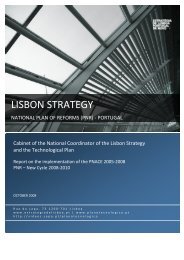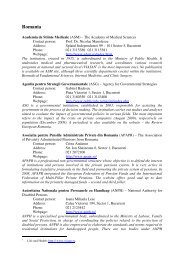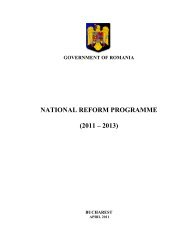National reform programme 2008-2010 Malta - European Commission
National reform programme 2008-2010 Malta - European Commission
National reform programme 2008-2010 Malta - European Commission
You also want an ePaper? Increase the reach of your titles
YUMPU automatically turns print PDFs into web optimized ePapers that Google loves.
Concerning horizontal aid one notes that over 70% of all aid granted in <strong>Malta</strong> goes to the<br />
manufacturing sector, primarily under existing aid schemes agreed with the EU during<br />
accession negotiations . As a result, the share of aid for horizontal objectives is comparatively<br />
low at 7.2% of total aid granted in 2006. This compares favourable with the level of 3.1%<br />
share registered in 2005. Moreover, the trend in the share of aid to horizontal objectives as a<br />
percentage of total aid is positive, and amount to 0.9 percentage points for the 2001-2006<br />
period.<br />
The specific realities faced by different Member States and regions should be appropriately<br />
taken into account. In this regard, small Island States like <strong>Malta</strong> face ad hoc geographical<br />
realities and disadvantages that cannot be sufficiently addressed only by horizontal measures.<br />
Given the nature of some of the State aid currently being granted in <strong>Malta</strong> it is not realistic at<br />
this stage to establish annual projections of State aid to be granted in a particular year. As<br />
pre-2004 schemes reach their end duration date as established in the Accession Treaty, it<br />
would be possible for <strong>Malta</strong> to determine annual State aid projections with an appropriate<br />
degree of certainty. . Moreover, as the restructuring aid package for <strong>Malta</strong> Shipyards ends in<br />
December <strong>2008</strong>, the level of State aid granted in <strong>Malta</strong> to the sensitive sectors will decline<br />
significantly in future years.<br />
It is envisaged that State aid policy in <strong>Malta</strong> will in general continue to move towards less and<br />
better targeted aid. Particular attention will also be given to the promotion of horizontal State<br />
aid measures, which reflects the message given to Member States in the Stockholm<br />
<strong>European</strong> Council in 2001 to "demonstrate a downward trend in State aid in relation to GDP<br />
by 2003" and also to "redirect aid toward horizontal objectives".<br />
Given <strong>Malta</strong>’s status as an Article 87(3)(a) region, it is envisaged that development aid<br />
measures will continue to be implemented in the NRP period. The nature of such intervention<br />
would bolster the rhythm of socio-economic development in <strong>Malta</strong>, contribute towards the<br />
realisation of <strong>Malta</strong>’s Vision 2015, and also support the further integration of <strong>Malta</strong> into the<br />
<strong>European</strong> economy.<br />
Moreover, Government will continue to remain vigilant for market imperfection situations that<br />
may arise in specific areas, especially in the wake of the specificities of the economy, as<br />
State aid may be an important policy instrument to mitigate such situations. In this way<br />
appropriate measures may be necessary to support the competitiveness of the economy,<br />
whilst honouring State aid principles.<br />
<strong>Malta</strong> <strong>National</strong> Reform Programme <strong>2008</strong>-<strong>2010</strong> - 33 -







